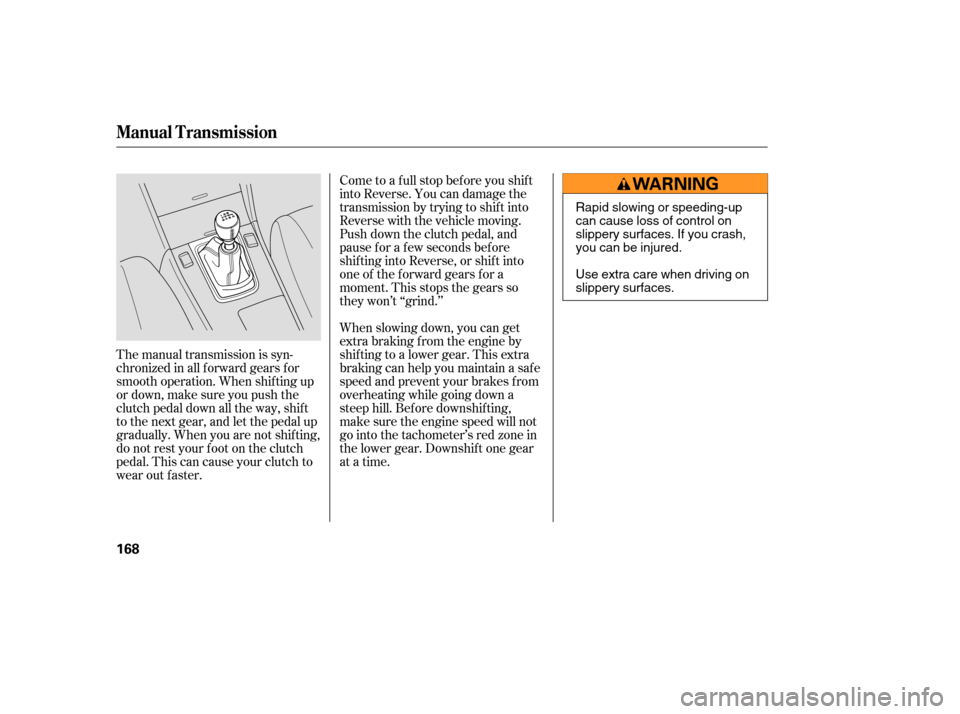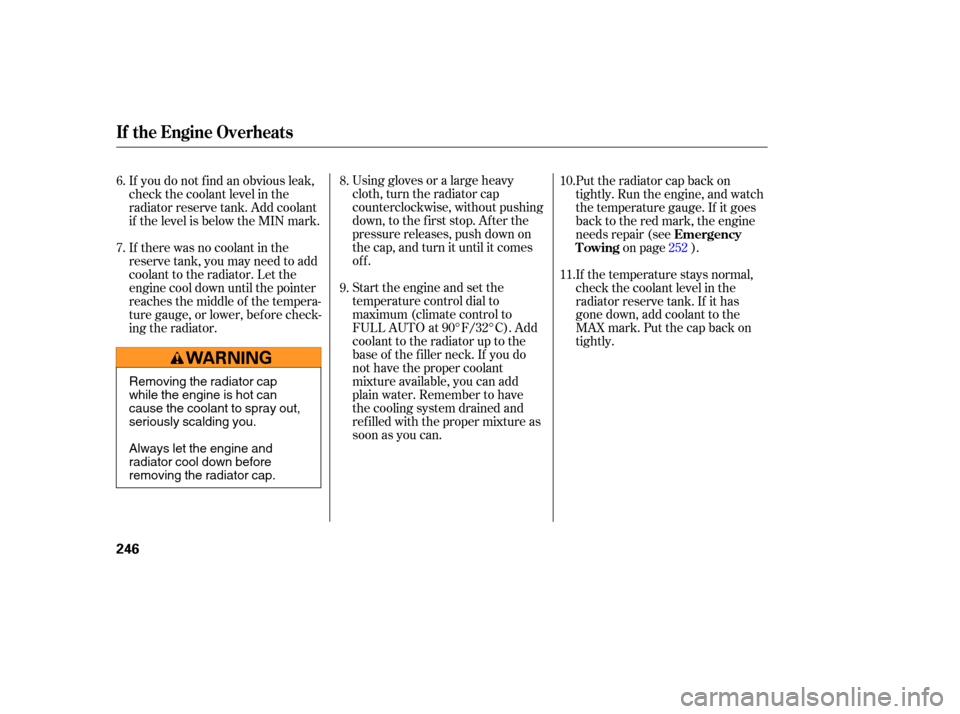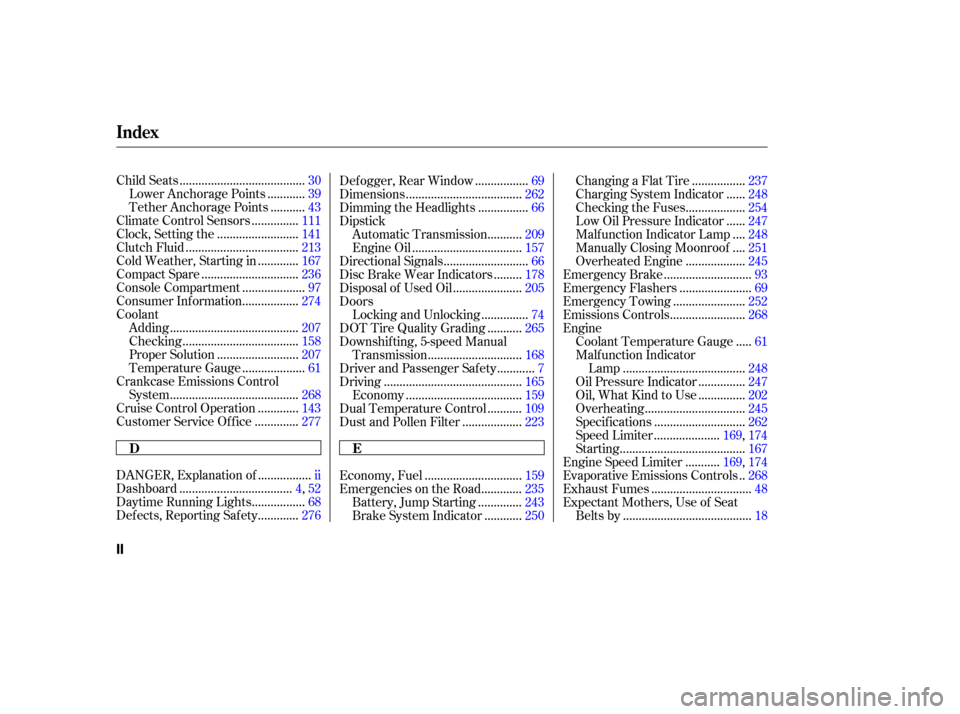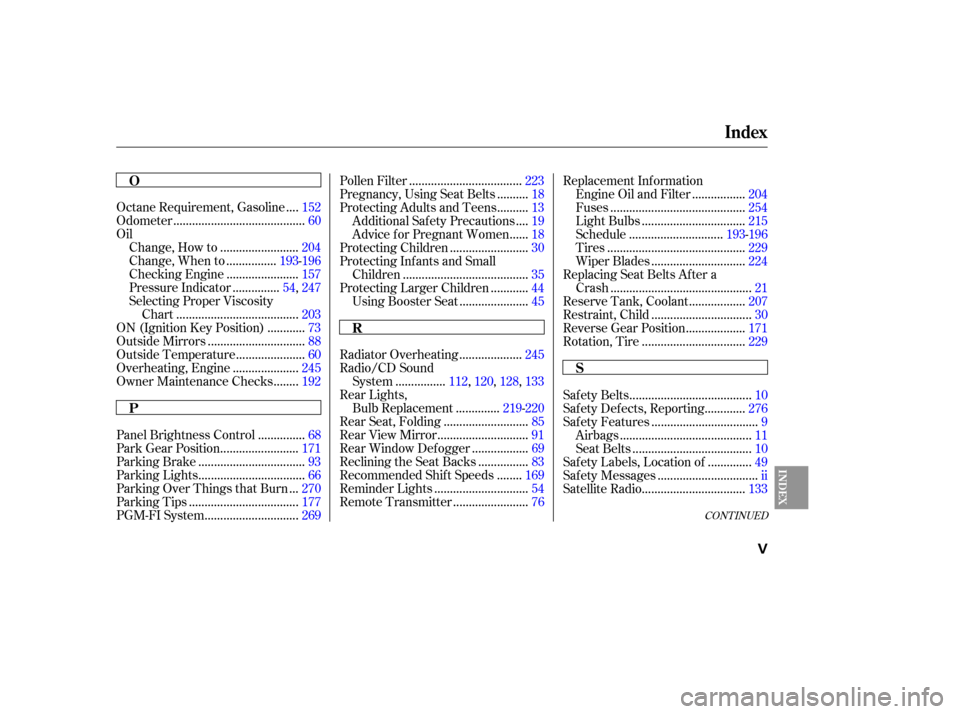engine overheat Acura TSX 2005 Owner's Manual
[x] Cancel search | Manufacturer: ACURA, Model Year: 2005, Model line: TSX, Model: Acura TSX 2005Pages: 288, PDF Size: 4.14 MB
Page 1 of 288

2005 TSX Online Reference Owner's Manual
Use these links (and links throughout this manual) to navigate through\
this reference.
For a printed owner's manual, click on authorized manuals or go to www.h\
elminc.com. Contents
Introduction ........................................................................\
................................................................. i
A Few Words About Safety........................................................................\
........................................ .ii
Your Vehicle at a Glance........................................................................\
............................................ .4
Driver and Passenger Safety ........................................................................\
..................................... .7
Seat belts, SRS, and child protection
Instruments and Controls........................................................................\
........................................ .51
Indicators, gauges, dashboard, and steering column
Features ........................................................................\
...................................................................... 99
Climate, audio, steering wheel, security, cruise control, and HomeLink
Before Driving........................................................................\
..........................................................151
Fuel, vehicle break-in, and cargo loading
Driving ........................................................................\
..................................................................... .165
Engine and transmission operation
Maintenance........................................................................\
.............................................................189
Schedules, fluid checking, minor services, and vehicle storage
Taking Care of the Unexpected........................................................................\
..............................235
Flat tire, dead battery, overheating, fuses
Technical Information........................................................................\
............................................ .259
Vehicle specifications, tires, fuels, and emissions controls
Warranty and Customer Relations (U.S. and Canada)................................................................273
Warranty and contact information
Authorized Manuals (U.S. only)........................................................................\
..............................277
How to order
Index........................................................................\
........................................................................\
...... I
Service Information Summary
Fluid capacities and tire pressures
Owner's Identification Form
Page 169 of 288

Come to a full stop before you shift
into Reverse. You can damage the
transmission by trying to shif t into
Reverse with the vehicle moving.
Push down the clutch pedal, and
pause f or a f ew seconds bef ore
shif ting into Reverse, or shif t into
one of the f orward gears f or a
moment. This stops the gears so
they won’t ‘‘grind.’’
The manual transmission is syn-
chronizedinallforwardgearsfor
smooth operation. When shif ting up
or down, make sure you push the
clutch pedal down all the way, shif t
to the next gear, and let the pedal up
gradually. When you are not shif ting,
do not rest your f oot on the clutch
pedal. This can cause your clutch to
wear out faster. When slowing down, you can get
extra braking f rom the engine by
shifting to a lower gear. This extra
braking can help you maintain a safe
speed and prevent your brakes f rom
overheating while going down a
steep hill. Bef ore downshif ting,
make sure the engine speed will not
go into the tachometer’s red zone in
the lower gear. Downshif t one gear
at a time.
Manual T ransmission
168
Rapid slowing or speeding-up
can cause loss of control on
slippery surfaces. If you crash,
you can be injured.
Use extra care when driving on
slippery surfaces.
Page 189 of 288

The added weight, length, and
height of a trailer will af f ect your
vehicle’s handling and perf ormance,
so driving with a trailer requires
some special driving skills and
techniques.Maketurnsmoreslowlyandwider
than normal. The trailer tracks a
smaller arc than your vehicle, and it
canhitorrunoversomethingthe
vehicle misses. Allow more time and
distance f or braking. Do not brake or
turn suddenly as this could cause the
trailer to jackknif e or turn over.
When climbing hills, closely watch
your temperature gauge. If it nears
the red (hot) mark, turn the air
conditioning of f , reduce speed and, if
necessary, pull to the side of the
road to let the engine cool.
If the automatic transmission shifts
f requently while going up a hill, shif t
to D .If youmuststopwhenfacinguphill,
use the f oot brake or parking brake.
Do not try to hold the vehicle in
place by pressing on the accelerator,
as this can cause the automatic
transmission to overheat.
When driving down hills, reduce
your speed, and shif t down to 2nd
gear. Do not ‘‘ride’’ the brakes, and
remember, it will take longer to slow
downandstopwhentowingatrailer.
Drive slower than normal in all
driving situations, and obey posted
speed limits f or vehicles with trailers.
If you have an automatic
transmission, use D position when
towing a trailer on level roads. D is
the proper shif t lever position to use
when towing a trailer in hilly terrain.
(See ‘‘ ’’ in the next
column f or additional gear
inf ormation.) Foryoursafetyandthesafetyof
others,taketimetopracticedriving
maneuvers bef ore heading f or the
open road, and f ollow the guidelines
below.
3
3
Driving Saf ely With a T railerMaking T urns and Braking
Driving on Hills
Driving on Hills
T owing Speeds and Gears
Towing a Trailer
188
Page 236 of 288

This section covers the more
common problems that motorists
experience with their vehicles. It
gives you inf ormation about how to
safely evaluate the problem and what
to do to correct it. If the problem has
stranded you on the side of the road,
you may be able to get going again.
If not, you will also f ind instructions
on getting your vehicle towed.......................
Compact Spare Tire .236
....................
Changing a Flat Tire .237
..........
If Your Engine Won’t Start . 241
Nothing Happens or the Starter Motor Operates ............................
Very Slowly .241
The Starter Operates ................................
Normally .242
................................
Jump Starting .243
............
If Your Engine Overheats . 245
.........
Low Oil Pressure Indicator . 247
..........
Charging System Indicator . 248
.......
Malf unction Indicator Lamp . 248
.......................
Readiness Codes .249
...............
Brake System Indicator . 250
..................
Closing the Moonroof . 251
......................
Emergency Towing .252
..............................................
Fuses .254
..........
Checking and Replacing . 254
Taking Care of the Unexpected
T aking Care of t he Unexpect ed
235
Page 246 of 288

Saf ely pull to the side of the road.
Put the transmission in Neutral or
Park, and set the parking brake.
Turn of f all accessories, and turn
on the hazard warning indicators.
If you see steam and/or spray
coming f rom under the hood, turn
of f the engine. Wait until you see
no more signs of steam or spray,
then open the hood.If you do not see steam or spray,
leave the engine running, and
watch the temperature gauge. If
the high heat is due to overloading,
the engine should start to cool
down almost immediately. If it
does, wait until the temperature
gauge comes down to the midpoint,
then continue driving.
If the temperature gauge stays at
the red mark, turn off the engine.
Look f or any obvious coolant leaks,
such as a split radiator hose.
Everything is still extremely hot,
so use caution. If you f ind a leak, it
must be repaired bef ore you
continue driving (see
on page ).
The pointer of the vehicle’s
temperature gauge should stay in
the midrange. If it climbs to the red
mark, you should determine the
reason (hot day, driving up a steep
hill, etc.).
If your vehicle overheats, you should
take immediate action. The only
indication may be the temperature
gauge climbing to or above the red
mark. Or you may see steam or
spray coming f rom under the hood.
1.
2.3.
4.
5.
252
CONT INUED
Emergency
Towing
If theEngineOverheats
T aking Care of t he Unexpect ed
245
Steam and spray from an
overheated engine can
seriously scald you.
Do not open the hood if steam
is coming out.
Driving with the temperature gauge
pointer at the red mark can cause
serious damage to your engine.
Page 247 of 288

Using gloves or a large heavy
cloth, turn the radiator cap
counterclockwise, without pushing
down, to the f irst stop. Af ter the
pressure releases, push down on
the cap, and turn it until it comes
off.
Start the engine and set the
temperature control dial to
maximum (climate control to
FULL AUTO at 90°F/32°C). Add
coolant to the radiator up to the
base of the f iller neck. If you do
not have the proper coolant
mixture available, you can add
plain water. Remember to have
the cooling system drained and
ref illed with the proper mixture as
soon as you can.Put the radiator cap back on
tightly. Run the engine, and watch
the temperature gauge. If it goes
back to the red mark, the engine
needs repair (see
on page ).
If the temperature stays normal,
check the coolant level in the
radiator reserve tank. If it has
gone down, add coolant to the
MAX mark. Put the cap back on
tightly.
If you do not f ind an obvious leak,
check the coolant level in the
radiator reserve tank. Add coolant
if the level is below the MIN mark.
If there was no coolant in the
reserve tank, you may need to add
coolant to the radiator. Let the
engine cool down until the pointer
reaches the middle of the tempera-
ture gauge, or lower, bef ore check-
ing the radiator.
7. 6.
8.
9.10.
11.
252
Emergency
Towing
If theEngineOverheats
246
Removing the radiator cap
while the engine is hot can
cause the coolant to spray out,
seriously scalding you.
Always let the engine and
radiator cool down before
removing the radiator cap.
Page 281 of 288

.......................................
Child Seats .30
...........
Lower Anchorage Points . 39
..........
Tether Anchorage Points . 43
..............
Climate Control Sensors . 111
.........................
Clock, Setting the .141
...................................
Clutch Fluid .213
............
Cold Weather, Starting in . 167
..............................
Compact Spare .236
...................
Console Compartment . 97
.................
Consumer Inf ormation . 274
Coolant ........................................
Adding .207
....................................
Checking .158
.........................
Proper Solution .207
...................
Temperature Gauge . 61
Crankcase Emissions Control ........................................
System .268
............
Cruise Control Operation . 143
.............
Customer Service Of f ice . 277
................
DANGER, Explanation of . ii
...................................
Dashboard .4, 52
................
Daytime Running Lights . 68
............
Def ects, Reporting Saf ety . 276................
Def ogger, Rear Window . 69
....................................
Dimensions .262
...............
Dimming the Headlights . 66
Dipstick ..........
Automatic Transmission . 209
..................................
Engine Oil .157
..........................
Directional Signals .66
........
Disc Brake Wear Indicators . 178
.....................
Disposal of Used Oil .205
Doors ..............
Locking and Unlocking . 74
..........
DOT Tire Quality Grading . 265
Downshif ting, 5-speed Manual
.............................
Transmission .168
...........
Driver and Passenger Safety . 7
...........................................
Driving .165
....................................
Economy .159
..........
Dual Temperature Control . 109
..................
Dust and Pollen Filter . 223
..............................
Economy, Fuel .159
............
Emergencies on the Road . 235
.............
Battery, Jump Starting . 243
...........
Brake System Indicator . 250................
Changing a Flat Tire . 237
.....
Charging System Indicator . 248
..................
Checking the Fuses . 254
.....
Low Oil Pressure Indicator . 247
...
Malf unction Indicator Lamp . 248
...
Manually Closing Moonroof . 251
..................
Overheated Engine . 245
...........................
Emergency Brake .93
......................
Emergency Flashers .69
......................
Emergency Towing .252
.......................
Emissions Controls .268
Engine ....
Coolant Temperature Gauge . 61
Malf unction Indicator ......................................
Lamp .248
..............
Oil Pressure Indicator . 247
..............
Oil, What Kind to Use . 202
...............................
Overheating .245
............................
Specif ications .262
....................
Speed Limiter . 169,174
.......................................
Starting .167
..........
Engine Speed Limiter . 169,174
.
Evaporative Emissions Controls . 268
...............................
Exhaust Fumes .48
Expectant Mothers, Use of Seat ........................................
Belts by .18
Index
DE
II
Page 284 of 288

CONT INUED
...
Octane Requirement, Gasoline . 152
.........................................
Odometer .60
Oil ........................
Change, How to .204
...............
Change, When to . 193-196
......................
Checking Engine .157
..............
Pressure Indicator . 54,247
Selecting Proper Viscosity ......................................
Chart .203
...........
ON (Ignition Key Position) . 73
..............................
Outside Mirrors .88
.....................
Outside Temperature .60
....................
Overheating, Engine .245
.......
Owner Maintenance Checks . 192
..............
Panel Brightness Control . 68
........................
Park Gear Position .171
.................................
Parking Brake .93
.................................
Parking Lights .66
..
Parking Over Things that Burn . 270
..................................
Parking Tips .177
.............................
PGM-FI System .269 ...................................
Pollen Filter .223
.........
Pregnancy, Using Seat Belts . 18
.........
Protecting Adults and Teens . 13
...
Additional Safety Precautions . 19
.....
Advice f or Pregnant Women . 18
........................
Protecting Children .30
Protecting Inf ants and Small .......................................
Children .35
...........
Protecting Larger Children . 44
.....................
Using Booster Seat .45
...................
Radiator Overheating . 245
Radio/CD Sound ...............
System . 112,120,128,133
Rear Lights, .............
Bulb Replacement . 219-220
..........................
Rear Seat, Folding .85
............................
Rear View Mirror .91
.................
Rear Window Def ogger . 69
...............
Reclining the Seat Backs . 83
.......
Recommended Shif t Speeds . 169
.............................
Reminder Lights .54
.......................
Remote Transmitter .76 Replacement Inf ormation
................
Engine Oil and Filter . 204
..........................................
Fuses .254
................................
Light Bulbs .215
.............................
Schedule .193-196
...........................................
Tires .229
.............................
Wiper Blades .224
Replacing Seat Belts Af ter a ............................................
Crash .21
.................
Reserve Tank, Coolant . 207
...............................
Restraint, Child .30
..................
Reverse Gear Position . 171
................................
Rotation, Tire .229
......................................
Saf ety Belts .10
............
Safety Defects, Reporting . 276
.................................
Saf ety Features .9
.........................................
Airbags .11
.....................................
Seat Belts .10
.............
Saf ety Labels, Location of . 49
...............................
Saf ety Messages .ii
................................
Satellite Radio .133
Index
O
P R
S
INDEX
V